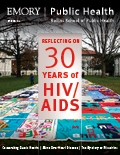The Spirit of Public Health
By Pam Auchmutey
A school dedicates a new building and honors the Rollins family legacy
On her first day of class at Rollins, Christine Khosropour 10MPH had no idea she would study safe water and sanitation in Ghana, ask Congress to increase university funding for global health study, or join the school as a research assistant after graduation.
And she never imagined helping dedicate the school’s new Claudia Nance Rollins (CNR) Building.
“Because of its location in the public health capital of the world [Atlanta], the collaborative vision on which it was founded, and the partners with whom it works, the Rollins School of Public Health is unique,” Khosropour told speakers and guests at the fall ceremony. “I do not think any of us could have gotten a better public health education anywhere else in the world.”
Among those present were members of four generations of the Rollins family, whose longtime generosity has enabled the RSPH to grow in size and stature in a relatively short time.
The name Rollins has become synonymous with action, change, discoveries
“The name Rollins has become synonymous with action, change, discoveries, and programs that prevent disease and save lives,” said Emory President James Wagner. “In the years ahead, thanks to what this building makes possible, the Rollins name will travel even further and mean even more.”
Former Emory President James Laney first met the Rollins family more than 40 years ago when he was dean of the Candler School of Theology. O. Wayne and Grace Crum Rollins became involved with the university through Candler and Wayne’s role as an Emory trustee. As Emory president, Laney supported creation of the School of Public Health, along with vice president for health affairs Charles Hatcher, in 1990. Wayne Rollins favored the idea of constructing a building to house the school.
“We were not shy in our aspirations, but we never imagined what could happen in 20 years,” said Laney of the school’s rapid growth since then.
Following Wayne’s death in 1991, subsequent gifts from the Rollins family led to the opening of the Grace Crum Rollins (GCR) Building in 1994 and provided support for faculty development and programs. In 2007, the family provided a $50 million lead gift to construct the Claudia Nance Rollins Building, named for Wayne’s mother. Like their father before them, Gary and Randall Rollins serve on Emory’s board (as trustee and trustee emeritus), representing 35 years of family leadership.
The spirit, the backbone, the DNA of the RSPH
“The legacy of O. Wayne and Grace Rollins is part of the spirit, the backbone, the DNA of the Rollins School of Public Health. To their descendants—the descendants of Claudia Nance Rollins—I hope you can feel the waves of affection and appreciation coming from your other family—the school that honors your name,” said Emory Board of Trustees chair Ben Johnson.
From the beginning, the school has drawn strength from collaborations with Atlanta-area universities and agencies such as CARE and the CDC. At Emory, the RSPH partners with other schools to offer dual degrees (more than any other school at Emory) and to advance research in fields such as cancer and HIV/AIDS.
“Access to this strong, internationally recognized School of Public Health is a powerful recruitment tool for graduate education across the university,” said Wright Caughman, Emory’s executive vice president for health affairs. “As a clinician, I can tell you that this collaboration is changing how our health care providers think about health, all to the good.”
Together, the nine-story CNR Building and the newly renovated GCR Building form a public health campus that promotes community and collaboration in and outside of Emory. The new building overlooks the CDC campus next door and the Atlanta skyline. The School of Medicine occupies laboratory space on one floor, strengthening research collaborations with public health colleagues.
We haven't slowed down yet
When James Curran became RSPH dean in 1995, he was charged with slowing the rapid growth of the school and balancing the budget. “We haven’t slowed down yet,” Curran told dedication guests. “We’ve been in the black for 15 years, and we’ve more than doubled our physical size. We now have the best facility for public health in the world—we’re now better than we were. The momentum is spread by the alumni, supporters, students, faculty, and staff who share in our mission.”
Today, the extended Rollins family includes more than 1,000 students and 5,000 graduates worldwide. Approximately half of the school’s alumni work in Atlanta and in Georgia, including Christine Khosropour, whose passion is researching the epidemiology of infectious disease.
“The school first gave me the knowledge and skills that I needed, then gave me real-life opportunities to use that knowledge and those skills in the real world, and then brought me back to the campus to hone and share what I have learned,” said Khosropour. “I promise gladly to spend the rest of my life trying to improve health and bring honor to the Rollins name.”

